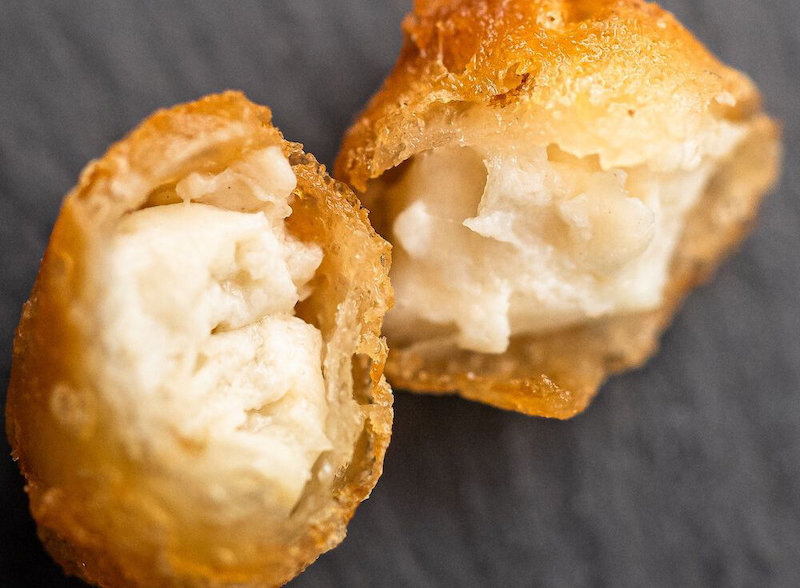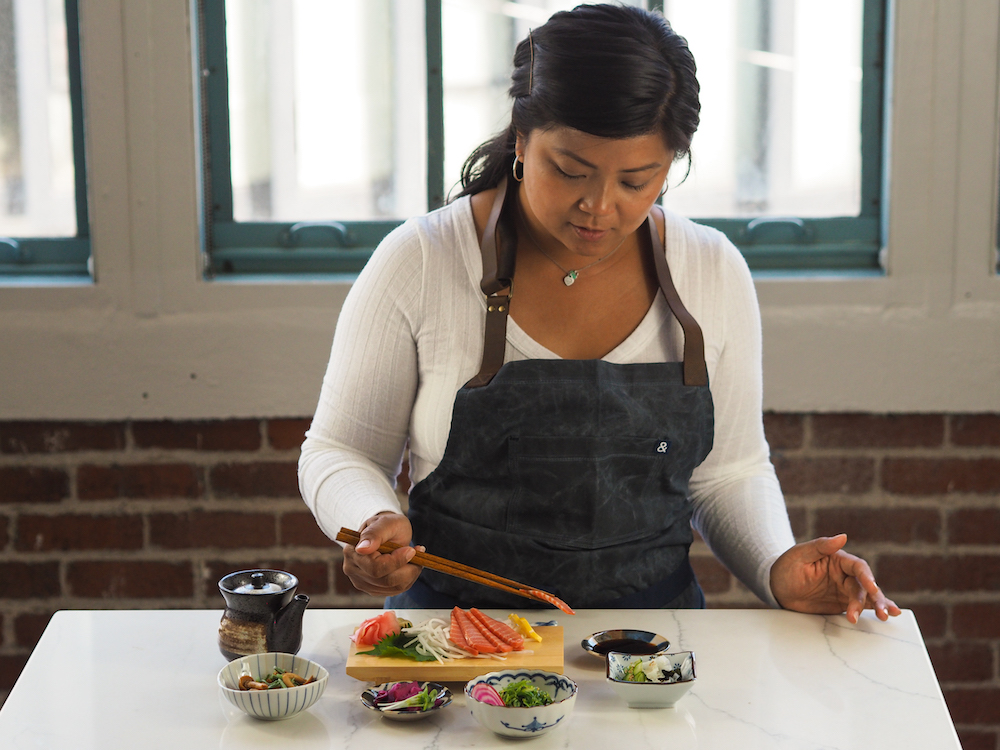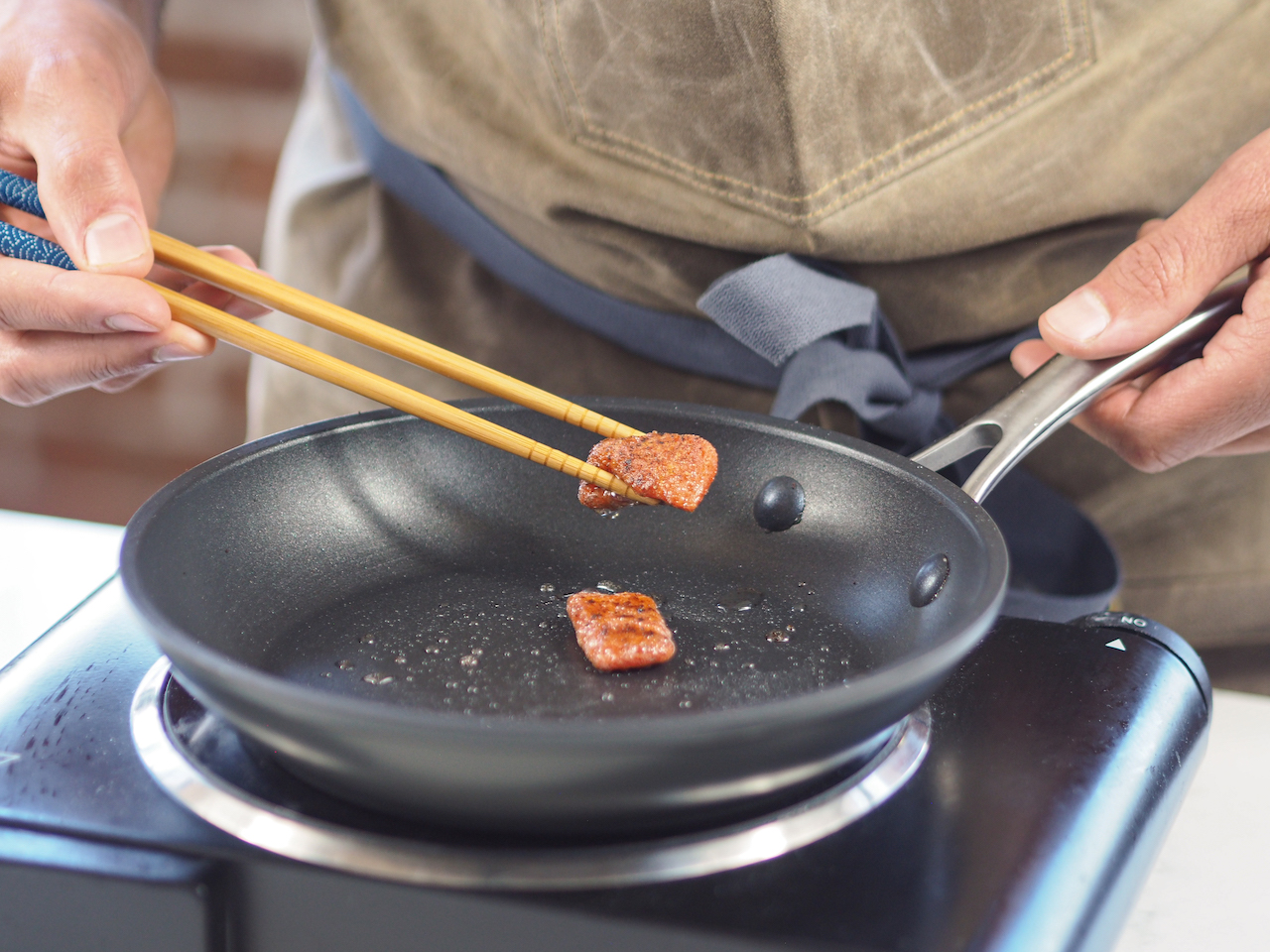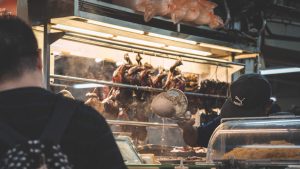Regardless of whether the ethical treatment of animals matters to you, it is disconcerting to know that the seafood we are currently consuming might be predisposing us to serious illness.
Fortunately, in about a year from now, we will have access to delicious seafood that is sustainably grown from stem cells with no genetic modification, and there’s no catch. This alternative to fished seafood couldn’t come sooner, reckons Naomi Clark-Shen, a Ph.D student with James Cook University Singapore.
“Marine life in many places of Southeast Asia is in very bad shape; it is one of the most threatened marine ecosystems in the world,” shares the young marine consultant.
We are in her laboratory in the university, and as we discuss her findings thus far, she lays the internal organs of a blackspot shark beside its carcass. She had previously published a paper on the sharks and rays caught by fisheries in Southeast Asia, which drew attention to the threat facing the region’s marine life.

“The bluespotted maskray has not yet been assessed by the International Union for Conservation of Nature’s (IUCN), so its threat level is unknown,” she says.
The sharks and stingrays she is studying come from the South China Sea, and she believes that her current research will shed light on how dangerous these fishing levels can be to the survival of populations. Soon, she will begin the analysis of these fishes’ stomachs, many of which may contain ocean litter, and hopes to eventually analyse their livers and meat, which are likely to contain toxic waste. She will be running tests on their spines too, to estimate the ages of sharks caught and determine the overall sustainability of these communities.
Across the course of her research, Naomi has come across some rare species that were killed by devastating fishing methods like trawling. A high-volume fishing technique, trawling involves dragging fishing nets across seabeds, which also destroys coral—as of 2016, the vast majority of Asia’s coral has already been obliterated.
“Fishing boats became a lot more advanced in the 1960s and more Asians joined the fishing industry,” she explains. She highlights that this disconcerting trend is exacerbated by some Asian countries not implementing fishing quotas and having very high rates of fish consumption. Currently, Asia consumes around two-thirds or more of the annual global catch.

The solution to this massive decline of Southeast Asia’s marine life might be seafood grown in bioreactors. Naomi believes that the current situation can still be salvaged if overfishing is minimised, and that ‘cell-based seafood’ might help us avert the worst-case scenario:“dead spots” in Asian oceans where there are no marine life.
A stem cell is an undefined cell produced by an organism, which can be nurtured into any particular type of cell. The human body, for example, produces stem cells that can become brain, heart, kidney, lung, liver or muscle tissue, wherever growth and repair is needed.
Unlike mock seafood made from plant proteins, cell-based seafood is seafood-like flesh (the muscle, fat and connective tissue of that organism) cultivated from stem cells inside a bioreactor. In this nutrient-rich environment, the stem cells of, let’s say a lobster, are stimulated by hormones and grown into a sizeable portion of lobster meat. In this instance, an intelligent crustacean won’t need to be slaughtered in order for us to benefit from its diverse nutrients, and enjoy realistic-tasting lobster meat.
“Cell-based seafood might be the disruptor that improves the dismal state of oceanic life,” explains Naomi.
She elaborates saying that almost 90% of marine fishes are fully fished, overfished, depleted, or recovering from overfishing; the global fishing fleet is two to three times larger than what the ocean can sustainably support, and populations of fish species caught by humans have dropped by 50%, with some experiencing even greater declines.
While most of our oceans have been overfished, at least 37% of the earth’s terrestrial surface is dedicated to farming. At the moment, our planet is being stretched to its limits to feed our human population.
In 2013, a Dutch pharmacologist from Maastricht University named Mark Post effected a paradigm shift when he created the first ‘cultured’ beef hamburger. Since then, many companies have followed suit, trying to create sustainable food sources from cells. However, their primary barrier of entry to the mass market is the same one faced by Post—his lab-grown beef patty cost him €250,000 to create.
The media in which cell-based seafood is cultured will remain extremely pricey—palm-sized yields might cost five figures to achieve—until advancements in technology allow producers to scale operations and improve cost efficiency. The cultured meat has to be treated very delicately within its media, as the media essentially functions as all the vital organs needed for respiration and metabolism.

The co-founder of the cell-based salmon-producing company shares that Wildtype’s mission is to create “the cleanest, most sustainable seafood on the planet.”
A prominent vanguard of the cultured meat industry, Justin echoes Naomi’s concerns, sharing, “Our planet is facing a food security crisis. While this issue predates COVID-19, this pandemic has exposed severe shortcomings in the supply chain for meat and seafood products that will only worsen as our population grows.”
He elaborates that Wildtype can possibly produce thousands of kilograms of seafood from a single stem cell.
“Wildtype salmon is not yet commercially available, but we are working hard to bring it to market as soon as possible! We recently launched an initiative to identify our first restaurant partners. Interested chefs or restaurant owners can reach out to us.”
Wildtype salmon is currently more expensive to produce than conventional salmon, but Justin and his team have managed to significantly reduce costs over the last three years. He did not divulge any specific figures, but shares that he wants Wildtype salmon to be cost-competitive with farmed salmon—which is much cheaper than wild salmon—by the end of this decade.
“BlueNalu is developing cell-based seafood products that are healthy for humans, humane for sea life and sustainable for our planet,” shares Lou Cooperhouse, President and CEO of BlueNalu.
“We can produce the same delicious and nutritious seafood products that consumers love by growing just the cells of muscle, fat and connective tissue in large stainless-steel tanks, similar to a brewery, and forming those cells into fillets, cubes for poké, and other dishes and products that consumers enjoy.”
Lou adds that BlueNalu is also currently expanding its team and broadening its array of expertise. Eventually, it aims to produce a wide variety of products to meet customer demand, and is also currently working closely with chefs and culinary influencers.

Although there are no cell-based seafood products commercially available anywhere in the world right now, BlueNalu aims to introduce its initial cell-based mahi-mahi products in select restaurants in the U.S. very soon, once the company meets the requirements of the U.S. Food and Drug Administration, and upon the completion of its 40,000-square-foot pilot-scale commercial production facility in San Diego. Following this, BlueNalu plans to expand its operations and introduce additional species and seafood products over the coming years.
Lou explains that cell-based seafood will eventually minimise food waste too, commenting, “From day one, BlueNalu has been focused on scalability and cost reduction. Today, seafood market pricing is based on supply, making it variable and unpredictable. You’re also paying for the parts of the fish that you don’t typically eat, like heads, tails, and bones. With BlueNalu seafood, our products have 100% yield, and we plan to market our products at price parity to conventional seafood products, while providing a steady supply that is predictable, safe and consistent to meet demand.”
With regards to Asia, Singapore-based producer Shiok Meats might be rolling out its products in a year or less. It currently costs Shiok Meats around US$3,500 to make a kilogram of prawn meat. The goal of this local start-up is to lower its cost to US$50 per kilogram by 2022.
Just last week, cell-based fish fillets were cooked for the first time in Hong Kong by prominent chef Eddy Leung.
“Before I cooked the fish it was quite firm, but after I cooked it the texture changed to being like real fish,” Leung told reporters. The fish fillets were made by Hong Kong start-up Avant Meats, which just announced its partnership with Vietnamese seafood giant Vinh Hoan Corporation.

When you make the switch to Wildtype salmon, Justin assures that you will still enjoy the authentic flavour and consistency of salmon, remarking, “our sushi-grade salmon has a very similar taste and texture to conventional salmon sashimi. We focus on fats, such as omega-3, that are characteristically high, in salmon. Fat is a major component of what creates that melt-in-your-mouth sensation that you get with fresh salmon sashimi.”
“With our yellowtail amberjack, BlueNalu has already demonstrated that our cell-based product has the same culinary characteristics as conventional seafood as well—whether it was cooked via grilling, searing, steaming, pan-frying or deep frying, or prepared via an acidified marinade as in poké, ceviche or kimchi, or whether it was presented and consumed in the raw state,” Lou says, describing the fish meat that BlueNalu created and served to a small group.
“When we enter the marketplace with our mahi-mahi, we will similarly show that our cell-based product will have the same mild, sweet flavour and will provide the same sensory experience as conventional mahi-mahi, and will perform the same in a variety of menu applications.”
Consulting firm Kearney estimates that by 2040, 35% of all meat consumed worldwide will be cultured.
Research invested in cell-based meat is likely to help us in our fight against a multitude of medical conditions too. As cell-based meat is based on regenerative medicine, advancements in cell-based meat can improve the science behind replacing damaged or diseased parts of the human body.
Refusing to support the Southeast Asian fishing industry will not only reduce pollution and our carbon footprint. It will also be saying ‘no’ to human rights abuses. For this reason, Europe did not import seafood from countries like Thailand for several years.
This cavalcade of pull factors has convinced investors to flood in. Shiok Meats, for example, received US$12.6 million in Series A funding in September 2020. In January 2021, BlueNalu announced that it had secured US$60 million in financing, the largest funding round to date (globally) in the cell-based seafood category. BlueNalu’s financers include seafood titans like Nutreco (Netherlands), Sumitomo (Japan), SeaPak (U.S.) and Saudi prince Khaled bin Alwaleed bin Talal. According to research firm MarketsandMarkets, the value of the global cultured meat market might rise to US$214 million in 2025 and might reach US$593 million by 2032.
“Food grown from stem cells is healthier because it is less affected by pollutants,” Naomi points out. She also showed me an American report that explores the increased risk of cancer among Singaporeans who consume seafood, due to carcinogens that these organisms are exposed to.
“Wildtype’s cell-based seafood is just as delicious and nutritious as the salmon we currently eat. It’s free of microplastics, toxic metals, parasites and other contaminants, and is truly sustainable—our operations have a transparent supply chain and will have no impact to wild salmon populations or sensitive coastal ecosystems,” vouches Justin of Wildtype’s salmon.
“Available year-round without seasonal market price spikes or supply outages, our skinless, boneless and ready-to-eat salmon will reduce food waste and save time in the kitchen.”
When humans stop eating marine life that has consumed dangerous quantities of heavy metals and toxic waste, along with livestock that is raised on steroids and antibiotics, how will our health, life expectancy and overall physiology change?
I guess we’ll find out in a few years’ time.






